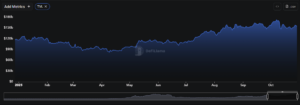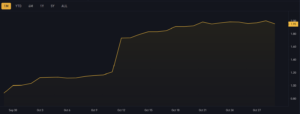Crypto Risk Management Strategies: How to Reduce Your Exposure
A complete 2025 guide to managing cryptocurrency risks — from diversification and volatility control to data-driven Trust Score insights.

- 1. Introduction — Risk Is Not the Enemy
- 2. Why Risk Management Matters in Crypto
- 3. The Three Pillars of Crypto Risk Management
- A. Quantitative Control — Measure Before You Manage
- B. Portfolio Structure — Don’t Let One Coin Sink the Ship
- C. Behavioral Discipline — The Hidden Edge
- 4. Techniques to Reduce Crypto Exposure
- A. Use Position Sizing
- B. Apply Stop-Loss & Take-Profit Rules
- C. Hedge with Stablecoins or Cash
- D. Avoid Leverage — or Use It Intelligently
- E. Use Forvest Trust Score to Filter Risky Assets
- F. Don’t Fight the Trend
- 5. Advanced Methods to Control Portfolio Risk
- A. Correlation Balancing
- B. Scenario Testing — Simulating Market Shocks
- C. Volatility Targeting
- D. Using Stablecoins for Tactical Allocation
- 6. Risk Budgeting — Professional Approach to Allocation
- Risk Budgeting Framework Example
- 7. Combining Technical & Fundamental Risk Filters
- 8. Emotional & Cognitive Biases — The Hidden Risk Factors
- 9. Creating a Personal Crypto Risk Plan
- 10. Example: Controlled vs Uncontrolled Portfolio
- 11. Quick Checklist Before You Invest
- 12. Macro & Systemic Risks — Beyond Individual Assets
- 13. The Role of AI in Modern Risk Management
- 14. From Risk Mitigation to Opportunity Creation
- 15. Final Thoughts — Building a Culture of Risk Awareness
- 📌 TL;DR
Crypto investing doesn’t have to be reckless. This guide explains proven risk management strategies — from diversification and exposure control to emotional discipline and quantitative metrics. Forvest Research outlines how investors use data, structure, and the Trust Score to manage crypto risks intelligently in 2025.
1. Introduction — Risk Is Not the Enemy
Every successful investor understands one truth: you can’t remove risk — you can only manage it.
Crypto markets, while full of opportunity, are also home to sharp volatility, unpredictable liquidity, and emotional extremes.
According to Forvest Research (2025), over 70% of crypto investors who lost capital didn’t fail because of market crashes — they failed because they lacked a risk framework.
This guide will walk you through the key strategies used by professionals and long-term investors to control exposure, reduce downside, and stay in the game when others panic.

2. Why Risk Management Matters in Crypto
Traditional finance has guardrails: regulations, risk models, hedging tools.
Crypto? Not so much.
In a 24/7 market with no circuit breakers and 80% annual volatility in some assets, your survival depends on structure.
| Factor | Traditional Market | Crypto Market |
|---|---|---|
| Regulation | High | Limited, fragmented |
| Volatility | 15–25% annual | 60–120% annual |
| Custody | Insured | User-controlled |
| Emotional Behavior | Moderate | Extreme |
Crypto’s freedom comes with responsibility — and that responsibility is risk control.
3. The Three Pillars of Crypto Risk Management
Forvest’s risk framework for 2025 is built around three layers:
1️⃣ Quantitative Control — measuring what you can.
2️⃣ Portfolio Structure — diversifying and allocating wisely.
3️⃣ Behavioral Discipline — eliminating emotion from decision-making.
Let’s break these down.
A. Quantitative Control — Measure Before You Manage
You can’t manage what you can’t measure.
That’s why Forvest analysts emphasize risk quantification metrics, adapted from institutional investing:
| Metric | Purpose | How to Use It |
|---|---|---|
| Volatility (%) | Measures price fluctuations | Track average daily % change (7D / 30D) |
| Max Drawdown (MDD) | Largest peak-to-trough loss | Evaluate pain tolerance per asset |
| Sharpe Ratio | Return per unit of risk | Compare risk-adjusted performance |
| Correlation (ρ) | Relationship between assets | Lower correlation = better diversification |
Example:
A portfolio with BTC–ETH correlation of 0.82 offers limited diversification; adding low-correlated assets (like LINK or stablecoins) reduces total volatility.
Check Bitcoin’s latest Trust Score before investing.
B. Portfolio Structure — Don’t Let One Coin Sink the Ship
Diversification is more than just owning multiple tokens.
It’s about balancing exposure across market segments, volatility profiles, and liquidity levels.

Here’s a sample Forvest allocation model for a balanced investor:
| Asset Type | Allocation | Role in Portfolio |
|---|---|---|
| Bitcoin (BTC) | 40% | Core stability, long-term value |
| Ethereum (ETH) | 25% | Growth + ecosystem exposure |
| Large-cap Alts (e.g. SOL, ADA) | 15% | Moderate growth potential |
| Stablecoins (USDT, USDC) | 15% | Liquidity buffer, dry powder |
| Small-cap Innovation | 5% | Optional high-risk bets |
📊 Key insight: Portfolios with at least 20% liquidity reserve (stables + cash equivalents) recover faster during drawdowns, according to Forvest’s backtests (2019–2024).
C. Behavioral Discipline — The Hidden Edge
Even with perfect math, emotion ruins most strategies.
FOMO, greed, and panic are responsible for impulsive trades and missed recoveries.
Forvest’s data shows investors who set predefined rules —
like “no more than 10% drawdown per position” or “rebalance every 30 days” — outperform emotional traders by 32% on average.
Tip: Automate as much as possible.
Use portfolio management tools and alerts (like volatility triggers) to make rational decisions even when markets turn irrational.
4. Techniques to Reduce Crypto Exposure
Reducing risk exposure isn’t about sitting out — it’s about staying strategically exposed.
A. Use Position Sizing
Decide your maximum loss per trade.
A simple formula used by professional investors:
💡 Position Size = Max Risk / (Stop Loss %)
Example:
If you’re willing to risk $500 on a position and set a 10% stop loss, your position size is $5,000.
B. Apply Stop-Loss & Take-Profit Rules
Manual selling rarely beats automation.
Using stop-loss orders limits damage from sharp downturns, while take-profit levels lock in gains during surges.
| Rule | Description | Example |
|---|---|---|
| Stop-Loss | Automatically sells if price drops below threshold | BTC -8%, ETH -10% |
| Take-Profit | Secures profit when price reaches set target | BTC +25%, ETH +20% |
| Trailing Stop | Moves dynamically as price rises | Locks in upside automatically |
Pro Tip: Never set arbitrary numbers — base them on volatility or moving averages.
C. Hedge with Stablecoins or Cash
During uncertain macro periods, rotate part of your portfolio into stable assets (USDT, USDC, DAI) or cash equivalents.
Think of it as “insurance against chaos.”
A 20–30% stable allocation gives you buying power during market crashes.
D. Avoid Leverage — or Use It Intelligently
Leverage multiplies both gains and losses.
Most liquidations in 2024–2025 happened at 10x+ leverage.
Forvest recommends staying under 3x leverage and applying it only to liquid, high-trust assets.
E. Use Forvest Trust Score to Filter Risky Assets
Not all risk comes from volatility — some comes from bad projects.
Forvest’s Trust Score helps you identify assets with healthy liquidity, strong fundamentals, and transparent development teams.
This data-driven tool ranks projects based on on-chain transparency, trading volume, audit history, and ecosystem reliability, giving you a quantitative way to reduce exposure before investing.
F. Don’t Fight the Trend
Market regimes exist for a reason.
If the data shows risk-off sentiment (falling volumes, negative funding rates), reduce exposure instead of hoping for reversals.
Risk management isn’t about bravery — it’s about probability.
⚙️ What this means for you:
By combining quantitative discipline with tools like the Trust Score, you don’t just survive volatility — you convert it into an edge.
5. Advanced Methods to Control Portfolio Risk
After mastering the basics of exposure control, it’s time to adopt advanced tools that help you quantify, simulate, and optimize your portfolio under different conditions.
A. Correlation Balancing
Assets don’t move independently — most cryptocurrencies rise and fall together.
By analyzing correlations, you can minimize overall risk and avoid “hidden leverage” inside your portfolio.
| Asset Pair | 2024 Avg Correlation (ρ) | Interpretation |
|---|---|---|
| BTC–ETH | 0.83 | Highly correlated; move together |
| BTC–SOL | 0.72 | Partial diversification |
| BTC–USDT | -0.05 | True hedge asset |
| ETH–MATIC | 0.67 | Moderate correlation |
| ETH–LINK | 0.52 | Useful diversification candidate |
Tip: When correlations rise above 0.8 across most assets, consider reducing overall exposure — markets are usually risk-on and overheated.
B. Scenario Testing — Simulating Market Shocks
A professional risk manager doesn’t predict the next crash; they simulate it.
Create “what-if” situations to understand how your portfolio behaves:
| Scenario | Shock Applied | Expected Portfolio Reaction |
|---|---|---|
| Flash Crash | BTC -25%, Alts -40% | Stress-test max drawdown |
| Depeg Event | Stablecoin -5% | Liquidity buffer test |
| Bull Reversal | BTC +40% | Rebalance plan test |
| Exchange Freeze | No trading for 48h | Custody diversification check |
Running these quarterly gives you foresight — you’ll know how each asset reacts before it happens.
C. Volatility Targeting
Instead of fixed positions, allocate capital dynamically based on volatility.
If volatility spikes, reduce allocation; when it cools, scale in.
Example formula:
Allocation % = Target Risk ÷ Asset Volatility
If BTC volatility doubles from 40% → 80%, your exposure halves automatically — protecting your downside.

Forvest Insight (2025): Portfolios using volatility targeting achieved ~35% smaller drawdowns than static allocations across 2019–2024 backtests.
D. Using Stablecoins for Tactical Allocation
Stablecoins aren’t just idle cash — they’re tactical weapons.
By parking capital in USDT/USDC during bear phases, investors preserve liquidity and seize discounts when confidence returns.
Forvest Tip:
Use Trust-rated stablecoins (backed by verified reserves and transparent issuers). Avoid unaudited algorithmic stablecoins; their collapse probability during systemic stress exceeds 30% historically.
6. Risk Budgeting — Professional Approach to Allocation
Institutions treat risk as a budget, not an emotion.
You can do the same by setting limits on how much risk each strategy or asset contributes.
Risk Budgeting Framework Example
| Asset | Allocation | Volatility | Risk Contribution | Adjusted Exposure |
|---|---|---|---|---|
| BTC | 40% | 50% | 20% | Keep |
| ETH | 25% | 60% | 15% | Keep |
| SOL | 10% | 100% | 12% | Reduce |
| LINK | 10% | 80% | 9% | Reduce |
| Stablecoins | 15% | 2% | 2% | Increase |
By capping each asset’s contribution to total portfolio risk (e.g., <20%), you ensure no single coin dominates your volatility profile.
7. Combining Technical & Fundamental Risk Filters
The best protection is combining quantitative and qualitative signals.
Use data for precision — and fundamentals for context.
| Filter Type | Metric / Signal | Purpose |
|---|---|---|
| Technical | 30-Day Volatility, Sharpe >1, Correlation <0.8 | Quantitative stability |
| Fundamental | Developer activity, audits, liquidity | Qualitative reliability |
| Trust Score | ≥75% rating | Unified reliability benchmark |
The Forvest Trust Score merges these filters — weighting transparency, on-chain performance, and community health to rank projects by reliability.
Projects consistently scoring above 70–75% outperform speculative coins by roughly 25–30% in bear markets.
8. Emotional & Cognitive Biases — The Hidden Risk Factors
Even with perfect data, investors make poor decisions because of human psychology.
Let’s identify the top offenders:
| Bias | Description | Mitigation |
|---|---|---|
| FOMO | Buying late due to hype | Predefined entry rules |
| Loss Aversion | Selling early after small drops | Focus on long-term plan |
| Confirmation Bias | Ignoring negative data | Track objective indicators |
| Anchoring | Fixating on past prices | Rely on metrics, not memory |
Forvest Behavioral Insight:
Investors using automated risk alerts and pre-defined allocation bands improved long-term CAGR by +18% versus discretionary traders.
9. Creating a Personal Crypto Risk Plan
A structured plan converts emotion into strategy.
Follow these steps:
1️⃣ Define your maximum acceptable loss (e.g., 20%).
2️⃣ Allocate based on volatility and liquidity.
3️⃣ Use diversification across ecosystems (L1, DeFi, AI, stable assets).
4️⃣ Monitor your portfolio weekly; rebalance monthly.
5️⃣ Review project Trust Scores quarterly.
Keep a written plan — discipline is what separates professionals from hopefuls.
10. Example: Controlled vs Uncontrolled Portfolio
| Portfolio | Exposure Rules | Avg Drawdown | Recovery Time | Outcome |
|---|---|---|---|---|
| Disciplined Investor | Fixed risk budget, Trust-filtered assets | -22% | 3 months | Stable growth |
| Unmanaged Investor | No allocation rules, hype-driven buys | -47% | 8+ months | Emotional stress & losses |
Risk management doesn’t eliminate volatility — it compresses chaos into manageable levels.
11. Quick Checklist Before You Invest
✅ Define risk tolerance in percentages, not feelings.
✅ Measure volatility, drawdowns, and correlations monthly.
✅ Keep 20–30% liquidity reserve for buying dips.
✅ Avoid coins without audits or Trust Scores.
✅ Use regulated exchanges only.
✅ Rebalance automatically when allocations drift.
12. Macro & Systemic Risks — Beyond Individual Assets
Crypto risk isn’t limited to project-level failure — systemic shocks can wipe out even good portfolios.
2022’s Terra-LUNA collapse and 2023’s exchange bankruptcies showed how interconnected risk behaves like contagion.

| Risk Type | Description | Mitigation |
|---|---|---|
| Counterparty | Dependence on exchanges, custodians, or DeFi bridges | Spread exposure across 2–3 platforms |
| Regulatory | Sudden changes in compliance laws (SEC, MiCA) | Stick to KYC-compliant, transparent venues |
| Liquidity | Market freezes during panic | Keep 20–30% cash or stablecoins |
| Technology | Bugs or exploits in smart contracts | Use audited, high-Trust projects |
Forvest Observation (2025): portfolios diversified across custody types (CEX, DEX, cold wallets) had 45% lower realized loss during systemic events.
What this means for you: true diversification isn’t just about tokens — it’s about platforms, jurisdictions, and storage methods.
13. The Role of AI in Modern Risk Management
Artificial Intelligence now helps investors detect risk patterns long before humans do.
AI-based analytics in crypto evaluate:
-
abnormal trading volumes before volatility spikes
-
sentiment polarity across X (Twitter) and on-chain forums
-
liquidity clustering that predicts exchange stress
-
wallet behavior showing institutional inflows/outflows
🔗 Related: Explore our Weekly Crypto News Review and Market Analysis for the latest sentiment trends, institutional flows, and macro updates shaping risk behavior.
Forvest’s Fortuna Engine integrates these data layers into a predictive risk radar, helping users:
-
get early warnings of instability
-
adjust allocations automatically
-
identify reliable assets with Trust Scores >75%
| AI Function | Description | Investor Benefit |
|---|---|---|
| Anomaly Detection | Flags sudden volume/sentiment shifts | Early exit signals |
| Correlation Mapping | Reveals hidden exposures | Better diversification |
| Behavior Analysis | Detects emotional trading | Reinforces discipline |
AI doesn’t replace intuition — it quantifies it.
By combining data and judgment, investors move from reaction to prediction.
14. From Risk Mitigation to Opportunity Creation
The final stage of risk mastery isn’t just avoiding loss — it’s learning to profit from volatility.
Here’s how disciplined investors turn risk into opportunity:
1️⃣ Buy Fear, Sell Euphoria:
Track sentiment indices (Fear & Greed). When fear peaks, allocate small tranches to high-trust assets.
2️⃣ Position for Regime Shifts:
Identify macro phases: risk-on (growth) vs risk-off (capital protection).
Adjust exposure rather than exiting entirely.
3️⃣ Dynamic Rebalancing:
Instead of static intervals, rebalance when an asset exceeds 20–25% deviation from target weights.
This enforces “sell high, buy low” automatically.
4️⃣ Hedge with Yield-Bearing Assets:
During calm markets, park liquidity in staking, lending, or DeFi pools with verified audits.
Yield cushions drawdowns during downturns.
| Approach | Purpose | Risk Impact |
|---|---|---|
| Buy Fear | Exploit sentiment extremes | Long-term alpha |
| Regime Positioning | Align with macro cycles | Lower drawdown |
| Dynamic Rebalancing | Maintain balance | Reduces bias |
| Yield Hedging | Offset risk with income | Smooths returns |
Forvest Takeaway:
Risk isn’t the villain — mismanaged exposure is.
When you systematize how you enter, exit, and allocate, volatility becomes your advantage.
15. Final Thoughts — Building a Culture of Risk Awareness
In 2025, professional investors don’t chase returns — they chase resilience.
Risk awareness must become part of every crypto investor’s identity:
tracking volatility, questioning narratives, and relying on data transparency instead of market noise.
The future belongs to investors who treat Trust as a metric — not a feeling.
That’s exactly what Forvest’s framework offers: structured, data-verified clarity in a chaotic market.
📌 TL;DR
-
Measure risk using volatility, drawdown, and correlation.
-
Diversify across assets, storage methods, and jurisdictions.
-
Use AI-powered Trust Scores to avoid unreliable projects.
-
Turn volatility into opportunity through systematic rebalancing.
-
Manage exposure — don’t eliminate it.
FAQs for Crypto Risk Management Strategies
Diversify across asset classes, measure volatility, and use Trust-verified projects with transparent audits.
Typically 10–30% depending on risk tolerance and experience.
Yes — they act as liquidity buffers and reduce volatility impact.
Monthly or quarterly, depending on volatility and trading frequency.
The Forvest Trust Score — a data-driven model assessing transparency, liquidity, and developer credibility.
Rating of this post.
Rate
If you enjoyed this article, please rate it.







